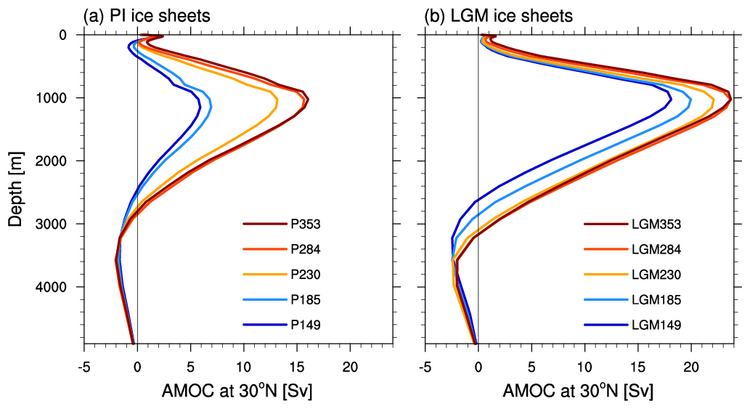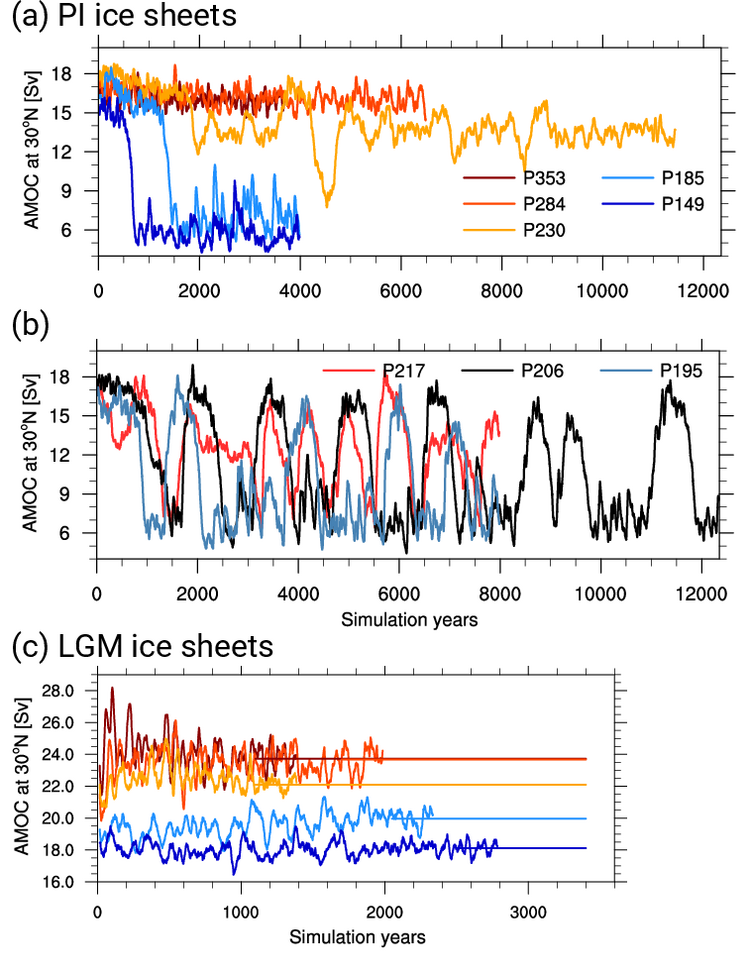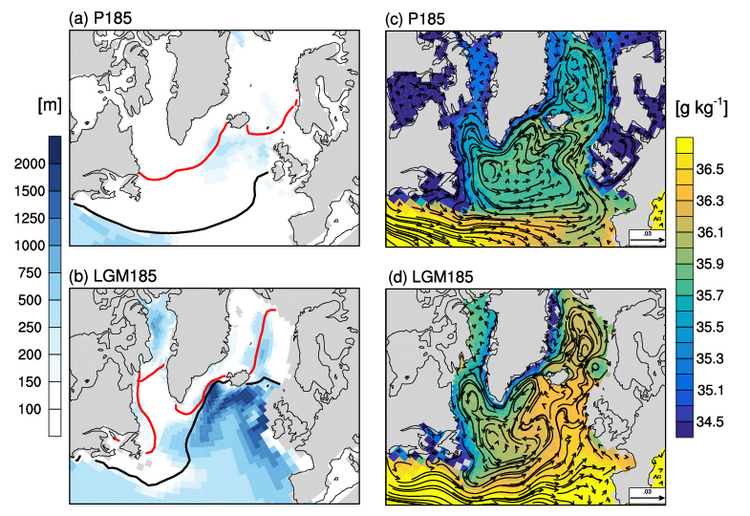AMOC response to different forcing and self-sustained AMOC oscillations
State-of-the-art coupled climate models produce very different states of the Atlantic Meridional Overturning Circulation (AMOC) in simulations of the Last Glacial Maximum (LGM). Many of them fail to capture the shoaling of the North Atlantic Deep Water (NADW) cell, as indicated by paleo records. The mechanisms that control the shoaling are not yet well understood. Changes in the AMOC have also been linked to past abrupt climate variations in the Earth system (Dansgaard-Oeschger events). The role of the ocean for those abrupt climate changes remains uncertain. We use steady state simulations with the Max Planck Earth System Model (MPI-ESM) to study the sensitivity of the AMOC and the deep ocean water masses to different forcings, specifically, different greenhouse gas concentrations (GHGs) and ice sheet configurations. Our simulations show that only under specific forcing conditions a shoaling of the NADW cell takes place. Further, abrupt climate variations occur through self-sustained oscillations of the AMOC under favorable forcing conditions. This allows to explore the mechanisms behind the aforementioned changes.
Simulations with pre-industrial and glacial ice sheets under different CO2 concentrations, ranging from preindustrial CO2 concentrations of about 353 ppm to glacial concentrations of about 149 ppm, reveal that low greenhouse gas (GHG) concentrations cause a decrease in overturning strength and a shoaling of the NADW cell (Fig. 1). However, the presence of glacial ice sheets causes an increase in the overturning strength and a deepening of the NADW cell. These two opposing effects tend to balance each other in the deep ocean.

In the simulations with preindustrial ice sheets, the AMOC strength responds nonlinearly to decreasing CO2 concentrations. There are two distinct AMOC modes: A strong and deep mode at high GHG concentrations, and a weak and shallow mode at low GHG concentrations (see also Fig. 2a and b). The weak and shallow mode occur in response to changes in the Southern Ocean and North Atlantic. First, Antarctic Bottom Water (AABW) becomes salty and dense enough to replace NADW in the North Atlantic. Second, the density gain over the North Atlantic is weak, and the Nordic Seas do not contribute to the formation of NADW. The latter is due to an eastward extension of North Atlantic Subpolar Gyre (SPG) and the North Atlantic and Nordic Seas being dominated by relatively fresh subpolar water (Fig. 3). Only a small amount of saline water of subtropical origin reaches the deep convection areas in the Iceland Basin and Irminger sea.
In the simulations with glacial ice sheets, the AMOC decreases linearly once the atmospheric CO2 concentration is below 284 ppm. To simulate a shoaling relative to the preindustrial AMOC state, GHG concentrations below the glacial level (185 ppm) are necessary (Fig. 1a). The low GHG concentrations enhance Southern Ocean shelf convection and brine release. Shoaling occurs only when the very salty Southern ocean shelf water contributes significantly to the formation of AABW. However, with glacial ice sheets the AMOC does not switch into a weak state. The density gain over the North Atlantic remains high also under low GHG concentrations. The subtropical gyre shifts northwards and the SPG contracts. Inflow of salty subtropical water extends over the entire Atlantic basin east of the Mid-Atlantic ridge and supplies salty water to the deep convection sites in the Iceland Basin and Irminger sea (Fig. 3). This maintains a continuous deep convection and a strong AMOC at low CO2 concentrations for LGM ice sheets.

Under preindustrial ice sheets and CO2 concentration of about 206 ppm the weak and the strong AMOC modes are unstable and the AMOC oscillates between the two states (Fig. 3). The frequency of these oscillation depends on the prescribed CO2 concentration, the higher the CO2 concentration the higher the frequency. Similar oscillations of the AMOC on millennial time scales were observed as abrupt warming and cooling events over Greenland and the North Atlantic throughout the last glacial period (57.000 to 29.000 years ago), the so-called Dansgaard-Oeschger events. We find, that the modeled oscillations are caused by the interaction of the AMOC and the SPG, which are coupled through wind- and density driven feedbacks. While the SPG controls the AMOC through transport of heat and salt into the deep water formation sites, the strength and location of deep-water formation affects the density driven part of the SPG and, thus, controls the mean strengths and extent of the SPG. Under certain conditions the effects of wind and density lead to changes in the SPG that cause abrupt changes in the AMOC. The mechanism supports the hypothesis that these self-sustained oscillations are a response to atmosphere-ice-ocean coupling.

Contact: Uwe Mikolajewicz, Marlene Klockmann1
1now at HEREON
References:
Klockmann, M., U. Mikolajewicz, and J. Marotzke, 2018: Two AMOC States in Response to Decreasing Greenhouse Gas Concentrations in the Coupled Climate Model MPI-ESM. J. Climate, 31, 7969–7984, doi:10.1175/JCLI-D-17-0859.1.
M.Klockmann (2017): The AMOC and its sensitivity to different climate forcings in the range of glacial to modern conditions, Dissertation, Berichte zur Erdsystemforschung, 194, doi:10.17617/2.2472757.
M.Klockmann, U.Mikolajewicz, J.Marotzke (2016): The effect of greenhouse gas concentrations and ice sheets on the glacial AMOC in a coupled climate model, Climate of the Past, 12, 1829-1846, doi:10.5194/cp-12-1829-2016.
